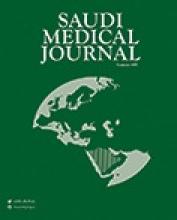SYSTEMATIC REVIEW
The association between pain and sleep in fibromyalgia
Keskindag & Karaaziz conclude that management strategies should be developed to decrease pain while increasing sleep quality in patients with fibromyalgia. Sixteen quantitative studies fulfilled the inclusion criteria. According to the results, increased pain in fibromyalgia was associated with reduced sleep quality, efficiency, and duration and increased sleep disturbance and onset latency and total wake time. Remarkably, depressive symptoms were also related to both pain and sleep in patients with fibromyalgia. Electronic databases, including PsycINFO, the Cochrane database for systematic reviews, PubMed, EMBASE, and Ovid were searched to identify eligible articles.
see page 457
ORIGINAL ARTICLES
Ambu AuraOnce versus i-gel laryngeal mask airway in infants and children undergoing surgical procedures. A randomized controlled trial
Alzahem et al compare the efficacy and performance of the pediatric Ambu AuraOnce (Ambu AO) mask (Ambu, Copenhagen, Denmark) and i-gel mask (Intersurgical Ltd., Wokingham, United Kingdom). They concluded that both devices demonstrated equally good performance with low morbidity. The Ambu AO had a statistical tendency towards easier insertion and less manipulation. Confirming this finding will require large scale trials. Three groups underwent a subgroup analysis: ≤5 kg (group 1), 5.1–10.0 kg (group 2), and >10 kg (group 3). There were statistically significant differences for higher leak pressure in group 2 (p=0.01) and group 3 (p=0.002) in favor of the i-gel, and for less manipulation in the Ambu AO in group 1 (p=0.04). Fiberoptic viewing was superior in group 2 for the i-gel (p=0.03) and in group 3 for the Ambu AO (p=0.02).
see page 482
Collapsing glomerulopathy, the Saudi Arabian scenario. A study of 31 cases and a review of literature
Husain compare the clinico-pathological features of collapsing glomerulopathy (CG) at a tertiary hospital in Saudi Arabia with the world literature. Thirty-one CG patients were identified, most were adult males. All the CG cases were idiopathic, all Arabs, none HIV positive, none of African descent, and none with a history of drug abuse. Upon treatment, remission (complete/partial) was noted in almost half the patients; around one fourth did not respond to treatment; and one fourth progressed to end stage kidney disease (ESKD). The median time taken to develop ESKD from the time of biopsy diagnosis was 23 months.
Light microscopy photomicrograph of a renal biopsy in a case of collapsing glomerulopathy shows segmental collapse of the glomerular tuft (arrow) with hyperplasia and hypertrophy of the overlying epithelial cells. Another tuft showing not otherwise specified type of segmental sclerosis with adhesion to the Bowman’s capsule is also noted (arrowhead). (Periodic Acid Schiff stain; original magnification x400.)
see page 509
CASE REPORT
Late metastatic endometrial carcinoma at the repair site of an abdominal wall incisional hernia
Meshikhes et al a 55-year-old female underwent abdominal panhysterectomy for EC in June 2009. She also received adjuvant chemotherapy, external beam radiation, and vaginal vault brachytherapy. She presented 3 years later with an incisional hernia in the para-umbilical area, and open mesh repair was performed in November 2012. Postoperatively, she developed wound infection with skin edge necrosis, which was treated by regular dressings and antibiotics. Vacuum assisted dressing was also used until the wound healed completely.
Computed tomography of the abdomen revealing A) right rectus abdominis muscle soft tissue mass suspicious of metastasis (white arrow) with peri-umbilical postoperative changes consistent with B) fibromatosis (yellow arrow)
see page 546
- Copyright: © Saudi Medical Journal
This is an open-access article distributed under the terms of the Creative Commons Attribution-Noncommercial-Share Alike 3.0 Unported, which permits unrestricted use, distribution, and reproduction in any medium, provided the original work is properly cited.








